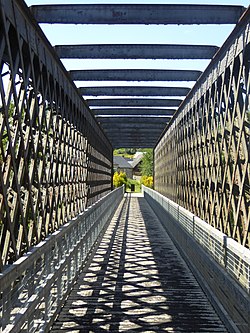Ballindalloch Railway Bridge | |
|---|---|
 The view along the bridge | |
| Coordinates | 57°24′50″N3°23′08″W / 57.41389°N 3.38556°W |
| Carries | Pedestrians, cyclists (formerly railway) |
| Crosses | River Spey |
| Heritage status | Category A listed building |
| Characteristics | |
| Material | Wrought iron |
| Longest span | 195 ft (59 m) |
| History | |
| Architect | Alexander Gibb |
| Fabrication by | G McFarlane, Dundee |
| Opened | 1863 |
| Location | |
 | |
The Ballindalloch Railway Bridge is a former railway bridge on the crossing the River Spey at Ballindalloch in Moray, Scotland. Built in 1863 as a part of the Strathspey Railway, it was in use until the line was closed in 1968. It is now designated as a Category A listed building, and carries pedestrians and cyclists over the river as a part of the Speyside Way.